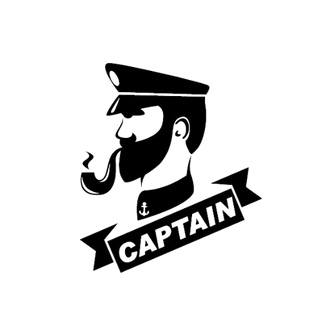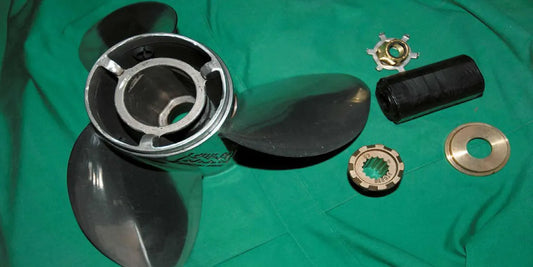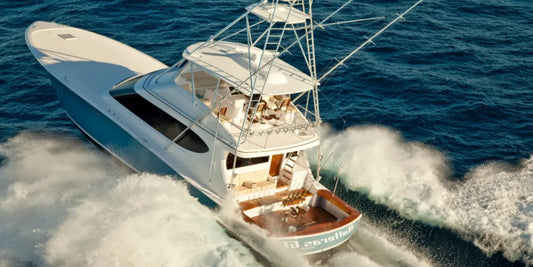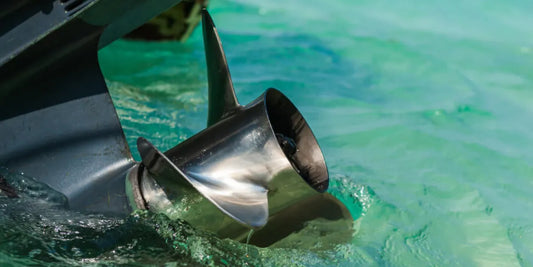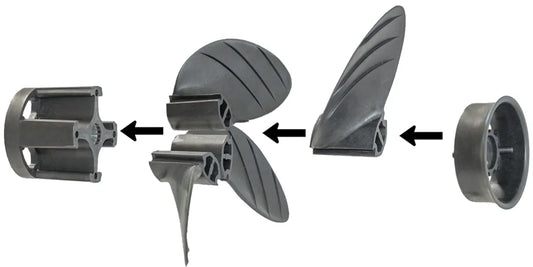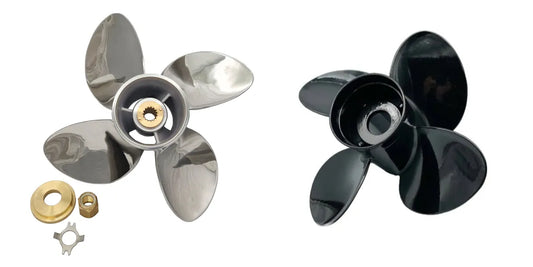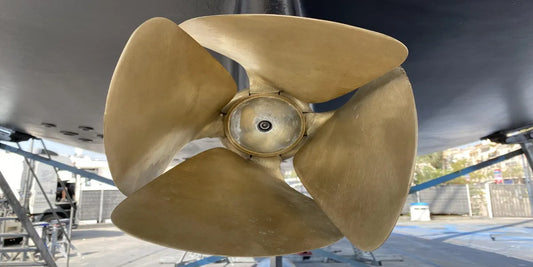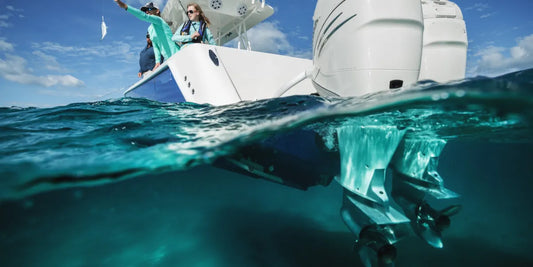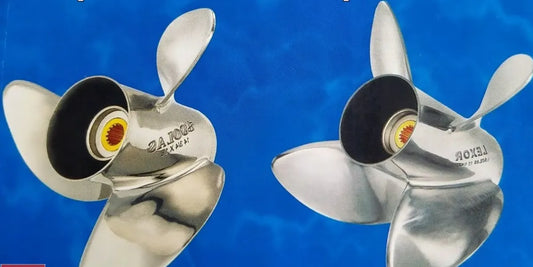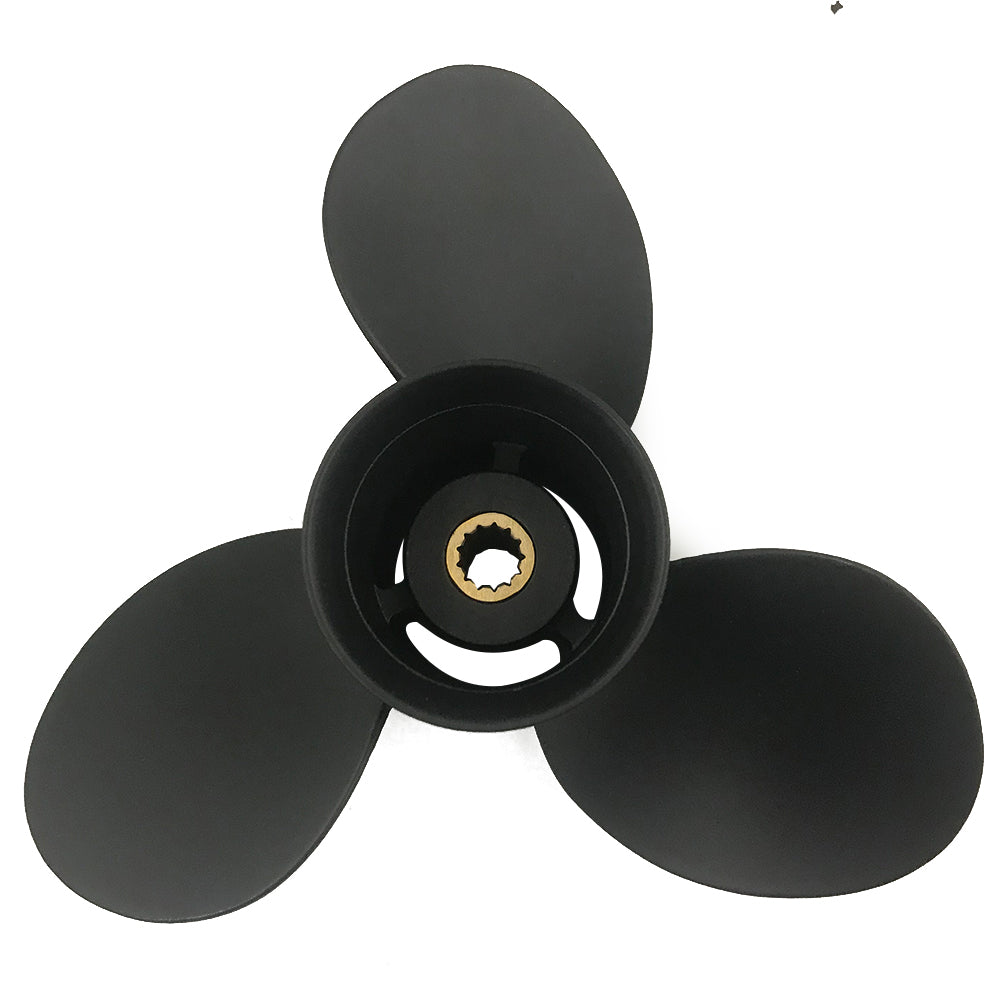Boating aficionados swear that performance, durability, and efficiency must be on the sacred altar when buying any equipment; an essential element that is often overlooked in this selection is the boat propeller. Out of all the materials available, stainless steel boat props remain superior, providing the highest degree of benefits to both casual and professional boaters. This article examines the world of stainless steel boat props and explores why they are the next big thing in contemporary boating. From their superior strength and wear resistance to the thrilling ride quality they impart on the water, let's explore why these props are an essential upgrade for anyone seeking to enhance their boating experience. Get ready to discover how stainless steel props can deliver improved performance, long-term cost savings, and utmost reliability when it matters most.
Understanding Stainless Steel Propellers

What are Stainless Steel Boat Props?
Known as propellers, these components play a crucial role in enhancing the efficiency and functionality of any boat equipped with a propulsion system. Designed from high-grade stainless steel, these props resist corrosion and withstand the rough conditions of marine settings. They also offer higher strengths when compared with aluminum propellers. Their sleek design and strength make stainless steel propellers capable of withstanding higher torque loads and providing greater resistance against impact, making them highly suitable for a wide range of applications, from speedboats to fishing vessels.
The primary attractive feature of these stainless steel props is their precision in manufacturing blade geometry, which reduces drag, increases fuel efficiency, and enhances overall performance in water. Additionally, many newer varieties of stainless steel props are engineered according to parametric hydrodynamic principles for smoother operation and less cavitation, an occurrence that restricts propulsion efficiency. By combining the above traits, steel props can be both a long-term investment and a substantial enhancement for any serious boater seeking reliability, speed, and power.
Advantages of Stainless Steel Over Aluminum
There are several unique advantages that stainless steel offers over aluminum, especially when considered by boaters seeking the very best in performance and durability. The greatest among these is the strength advantage of stainless steel. This strength enables engineers to manufacture blades that are thin yet retain their structural integrity, resulting in less drag and improved efficiency, which in turn implies increased speed and fuel efficiency. Furthermore, stainless steel also resists deformation, so it does not bend or lose its performance, unlike aluminum, under high-stress conditions, such as at very high speeds or in quite rough waters.
Durability is another characteristic of stainless steel. Aluminum, in comparison, will deform, chip, or even corrode if left unused for a while, especially in saltwater, whereas stainless steel is able to retain its structural integrity and provide long-term reliability with minimal maintenance. Hence, these types of propellers are ideally suited for heavy-duty applications or relatively powerful engines. Additionally, the advanced hydrodynamic designs often used in conjunction with stainless steel props further enhance their performance capability—they accelerate better, provide smoother rides, and offer improved handling even in the most adverse situations.
Stainless steel propellers would cost more initially compared to aluminum ones, but ensuring longevity, consistent performance, and resistance to wear and tear makes them a worthwhile investment in the long run. For any boater who values speed, efficiency, and reliability most, stainless steel stands as a premium option.
Stainless Steel Propeller Applications
Stainless steel propellers are sought after for providing excellent thrust performance in various outboard motor applications based on both recreational and professional modes of boating. These propellers find applications in high-performance boats, fishing boats, and larger vessels where maximum thrust and durability are required. Being highly efficient and flexible, stainless steel propellers have gained a reputation for their improved initial acceleration and greater top-end speed, making them well-suited for water sports such as wakeboarding and skiing.
Additionally, in situations where damage resistance is crucial, such as shallow waters laden with debris, these propellers are most often found. The ability to maintain consistent performance in a hard-surfaced environment also makes them a choice for offshore and saltwater applications, where corrosion resistance is crucial. There appears to be evidence that stainless steel propellers last longer in harsh conditions and provide better fuel efficiency, allowing both casual boaters and professionals to achieve guaranteed and useful thrust without frequent changes or repairs.
Performance of Outboard Propellers

How Propeller Design Affects Boat Performance
Propeller design plays a significant role in creating faster, more fuel-efficient, and better-handling vessels. Blade pitch, size, and the number of blades are essential parameters that affect power conversion efficiency, from engine to thrust. For example, a higher-pitch propeller displaces more water with each turn, favoring higher speeds. This, however, can draw more engine power, thereby reducing acceleration. Lower-pitch propellers, on the other hand, work better for thrust at low speeds, which guarantees steady handling and fast acceleration for purposes such as water skiing and maneuvering through tight waterways.
As to the number of blades, it is a balancing act between speed and smoothness. Three-blade propellers offer the perfect compromise between top speed and versatility, which is why they are widely accepted for recreational boating needs. In comparison, four- or five-blade ones provide ultimate smoothness and the torque necessary for heavier boats and towing. Then there is the material, typically stainless steel or aluminum, with, of course, certain advantages attached to each one regarding performance. Stainless steel, being much stronger, allows for more intricate designs with better precision and fuel efficiency. Aluminum tolerances are sufficiently suitable for less demanding situations and lighter boats.
Newer developments, such as cupped blades or variable-pitch designs, offer some customization to meet specific concrete performance goals. Cupped blades provide more bite and lessen cavitation, improving acceleration and top-end speed. Propeller design is not a one-size-fits-all approach; understanding exactly which features suit the weight of the boat, engine horsepower, and intended purpose can provide significant performance improvements and, more importantly, a complete sense of joy in motion.
Choosing the Right Pitch and Diameter
Pitch and diameter are two fundamental aspects of the propeller that have direct impacts on the boat's performance. The width of the propeller defines the diameter at its broadest points, which typically determines the amount of water displaced with every rotation. A larger-diameter propeller usually provides more thrust and is suited for heavier boats or when extra power is needed. Therefore, pitch is how far a propeller can be said to move along one full rotation through the water. A higher pitch means higher speeds, but more engine power, whereas a lower pitch means faster acceleration, making it suitable for towing or navigating rough water.
Matching the pitch and diameter to the boat's specifications, including weight, engine RPM range, and primary use, is therefore essential to ensuring optimal performance and balance. For instance, performance may be highly optimized by using the RPM range recommended by the manufacturer, as it would reduce strain on the engine and enhance efficiency. The weight balance of the engine can be compensated by a heavier boat through the use of lower pitch; in contrast, a lighter boat optimized for high speed will likely benefit from higher pitch. Trial and error might become essential as the first steps in determining an acceptable setup for any given boating situation.
Influence of Blade Count on Performance
The number of blades on a propeller has a vital impact on boat performance by providing the grounds on which speeds, stability, and fuel efficiency are balanced. Traditionally, propellers with fewer blades, such as two or three, are generally considered to provide greater top speeds compared to those with more blades, due to reduced drag. Such applications are typical for performance because maximum top speed is of the essence. Propellers having four or more blades provide a larger surface area, thereby promoting better thrust and grip in the water. This capability makes them more suitable for heavier vessels or those operating in rougher conditions, with smooth handling and vibration control.
For example, a three-blade propeller offers a higher top-end speed and is sometimes preferred for use in recreational speedboats or in racing. Four blades, however, while providing smooth acceleration and minimal slippage, are also the propeller of choice for towing water sports, including wakeboarding. The additional blades also contribute to hole shot and efficiency maintenance at lower speeds.
Further data validating blade count versus fuel economy show that tests on three versus four blades become proving grounds for observing the four-blade variations deliver 5-10% greater fuel economy under certain load conditions and speeds. Ultimately, the blade count is something to consider based on personal considerations for the optimum balance and performance, stability, and operational efficiency pertinent to their maritime activities.
Top Brands and Models of Stainless Steel Boat Propellers

About Yamaha and Its Range of Outboard Propellers
Synonymous with the marine industry, Yamaha is reputed for inventiveness and dependability in its outboard motors and propellers. Their spectrum of stainless steel ranges is designed to provide better performance, durability, and efficiency for various types of vessels and applications. Yamaha propellers generate thrust and acceleration efficiently while maintaining fuel efficiency; hence, they come into high demand from both pleasure and professional boaters.
Another high-end series from Yamaha includes the Reliance Series of stainless steel propellers for midrange outboards. The design strikes a balance between strength and lightness, a prerequisite for good handling and speed without compromising fuel efficiency. The Saltwater Series II is specifically designed for larger engines operating in offshore conditions. The Saltwater Series II has a reputation for excellent corrosion resistance, a crucial attribute in marine environments.
A further advantage of Yamaha is an advanced feature, namely the Shift Dampener System, which minimizes noise and vibrations during operation. With well-precision casting combined with a polished finish, Yamaha propellers perform better and remain an eternal piece. Whether for work or pleasure, Yamaha propellers cater to every need in the boating world, thereby enhancing the overall oceanic experience.
Mercury's Top Stainless Steel Choices
Mercury brings a strong line of stainless steel propellers engineered to provide marine craft with considerable performance, durability, and fuel efficiency. One good example is Mercury Enertia, with its blade geometry designed to perfect top speed and acceleration. The Mercury Enertia propeller is made with Mercury's patented X7 alloy, ensuring strength and corrosion resistance, the perfect companion for harsher marine environments.
The Bravo I was also highly favored for having a special high-performance trim. It boasts a larger diameter and more blades to ensure a secure grip and reduce slippage, which is ideal for high-speed watersports or operators. Another worthy mention is the Tempest Plus. The Tempest Plus propellers provide lift and improve handling for heavier boats such as pontoons or fully loaded fishing rigs.
According to product tests conducted by the industry and its users, Mercury propeller options and their efficiency raise fuel efficiency while simultaneously offering a smooth performance with minimal vibrations due to cavitation. Technologically advanced and quality-controlled, Mercury stainless steel propeller selections meet the needs of various marine crafts while ensuring long-lasting function and service.
Solas and Quicksilver Comparison
When comparing Solas and Quicksilver, we recognize that both brands are designed with distinct advantages to meet the customer's finer needs. Solas propellers are known for their more advanced engineering and durability focus. Manufactured from modern materials such as stainless steel and high-strength aluminum, the Solas propeller is built to withstand wear from a wide range of water conditions, including freshwater lakes and saltwater environments. They are also praised for their precision in blade design, enabling improved acceleration and top-end speed while conserving fuel efficiency.
On the other hand, Quicksilver propellers excel in their versatility and continuous innovations, making them a valuable ally of Mercury Marine. The propellers are manufactured to deliver optimized performance for various types of boats, offering options that cater to casual boaters, anglers, and high-speed enthusiasts. Many Quicksilver models are equipped with patented technologies, including enhanced ventilation systems and rake angles, that further improve handling, particularly in choppy waters. A significant number of users also appreciate how reliably and consistently this brand performs, as well as its compatibility with Mercury engines, which ensures seamless installation and dependable results.
Thus, the choice between Solas and Quicksilver depends on the kind of boat with which it will be propelled, its intended use, and the particular performances desired. Solas is thus suitable for intense use where efficiency and endurance are required throughout varying conditions. In contrast, Quicksilver answers users' needs for innovation, adaptability, and pinpointed performance for when the boats are Mercury-powered. Both brands are renowned for their quality and reliability and are highly regarded among marine enthusiasts worldwide.
Upgrading to Stainless Steel Props

When to Consider an Upgrade
The upgrade to stainless steel propellers becomes a worthwhile investment in a few scenarios. If your current propeller has wear and tear due to chipping, cracking, or warping, replacing it with a stainless steel propeller can significantly improve performance and add durability. Another upgrade opportunity may arise for those seeking better fuel economy or increased speed, as stainless steel props provide these benefits due to their greater rigidity and improved design for water displacement. In situations where navigation involves a challenging environment with debris or shallow waters, stainless steel offers significantly more resilience, resulting in a longer lifespan and fewer replacements.
Some of the fine moments for considering an upgrade are when performance is to be fine-tuned for specific applications, such as water sports or cruising. With its enhanced adjustability and precision, stainless steel propellers can provide distinct alterations to acceleration, top speed, and overall handling, tailored to the unique requirements of various boating activities. For those who are frequent boaters or professionals whose operations depend heavily on total performance and reliability, they may foresee long-term benefits and enjoy stainless steel propellers on the water.
Installation and Maintenance Tips
Proper installation of stainless steel propellers and their routine maintenance are essential to getting the best from them and, in return, ensuring they outperform and last. Start the installation by inspecting the propeller shaft thoroughly for any debris, dents, or corrosion that might hinder its fit or functionality. Apply a marine lubricant to the propeller shaft to facilitate smooth entry and exit and prevent future stubborn removal. Always fasten using a locking nut suited for the job; also, ensure the thrust washer is placed correctly to avoid imbalance or vibrations while in use.
In terms of maintenance, it is necessary to inspect regularly for dents, bends, or cracks, especially after cruising in shallow or debris-filled waters. Rinse with freshwater every time after usage to clear any salt, algae, or dirt-gross buildup that could cause corrosion later on. Remove the propeller and inspect for any fishing lines or debris wrapped around the shaft, as these can cause damage to the seals, leading to expensive repair bills. Store your boat with the propeller in a dry, covered area when it is not in use to prolong its lifespan and ensure optimal performance. The inclusion of all these into your routine helps maintain the longevity of your stainless steel propeller, ensuring it continues to work efficiently.
Cost Considerations for Stainless Steel vs. Aluminum
The cost is a crucial parameter that differentiates stainless steel and aluminum propellers, where the subtraction has to take into account the initial purchase, long-term performance, and maintenance demands. Aluminum propellers are often the initial choice for tradesmen or casual boaters who have limited funds to spend at one time. This would be the best bargain for those using their vessels only for recreational purposes or under less demanding conditions.
Stainless steel, thus, might be cast to be more expensive from beginning to finish, yet, more often than not, it brings added value during the lifespan of the vessel. The heavier duties they hold can withstand greater levels of wear and stress, especially in high-performance or rough-water environments. This, in turn, leads to less frequent replacement and, ultimately, lower long-term maintenance costs. Additionally, stainless steel propellers offer better efficiency due to their strength, which enables thinner blades that allow for higher boat speeds, improved fuel economy, and enhanced overall handling.
The answer to the question between stainless steel and aluminum propellers should take into account not just the up-front cost but also the potential use, frequency of boating, and the performance benefits associated with each material type. Those seeking durability, efficiency, and high-performance benefits may consider stainless steel as a worthwhile long-term investment. However, for those interested in more affordable options, aluminum alternatives may be a better choice.
Propeller Selection for Different Outboard Engines

Choosing Props for 40-Horse-Power Outboard Motors
When selecting a propeller for a 40 HP outboard engine, I first consider the particular performance aspects I need for my boating activity. For example, if I am aiming for top speed and smooth acceleration, I might choose a stainless steel propeller for its well-deserved reputation for strength and efficiency. Thin steel blades are a trademark of stainless steel props, which help enhance performance by reducing drag underwater. They tend to be expensive, though, which weighs on my decision between what I will pay and my long-term plans.
I go for an aluminum prop if I want something cost-effective that offers more flexibility. The aluminum propellers are not very expensive to replace and are lightweight, making them suitable for general-purpose usage in non-heavy traffic areas. They are not as durable as stainless versions, but perhaps this factor could save you money on replacements, which can be handy if you tend to be a rather casual or recreational boater.
Ultimately, my decision depends on three factors: whether the boat will meet my performance needs, whether I can afford it, and whether I will use it frequently. Funny enough, I think in terms of making sure the pitch and diameter of the propeller are also compatible with the engine specifications. It is prudent to either consult the manual that comes with my outboard motor or ask a trusted marine technician to ensure that I have chosen the best propeller for my particular engine and operating conditions.
Knowing About Hub Kits and Compatibility
Hub kits play a major role in ensuring the propeller fits well with the outboard engine and performs its job efficiently. They sit between the propeller and the drive shaft of the engine to ensure a proper fit, while also helping to absorb vibrations and shield the engine in the event of any impact. When selecting the right kit for my propeller, I would consider the compatibility with my engine model and the manufacturer's specifications, of course. Many newer hub systems can intermix; it gives flexibility. Still, I will want to confirm that the kit I decide on will fit my prop and engine setup without any issues.
Whenever I choose one to install, I make sure it is specifically designed for my brand and size. Some hub systems will fit a multitude of brands, but with slight differences in fit or perhaps due to the sturdiness of materials, I have concerns. I also consider whether it is easy to install and whether I can obtain spare parts or replacements if needed. I want a high-quality hub kit, as it will prolong the life of my propellers and protect my engine from damage arising from their poor fit or unforeseen impacts that may occur during operation. Usually, I base my decision on manufacturer recommendations, reviews, and the advice of marine professionals who are familiar with my boating conditions and the type of engine I am installing.
Recommendations for Johnson and Evinrude
For Johnson and Evinrude motors, I recommend selecting a propeller hub kit specifically designed for these types of engines to achieve optimal performance and compatibility. These motors are said to be the most reliable, though the selection of the correct hub kit remains paramount in preserving their efficiency and longevity. In my experience, OEM (Original Equipment Manufacturer) or high-quality aftermarket parts fit the best, thereby minimizing the chances of propeller or engine damage during use. Additionally, these kits often come with straightforward installation instructions that even a novice mechanic can follow.
One primary consideration I take into account as to what kind of boating I most frequently take part in: cruising, fishing, or water sports-another factor to consider when matching the hub kit to the demands of operation. Higher stress due to heavy loads or frequent high-speed use may necessitate the use of more durable materials. Another valuable insight, especially regarding what has worked well for others in similar conditions, would be to consult with marine experts or check out forums and reviews from other Johnson and Evinrude owners. Properly chosen, the right hub kit can improve your confidence in performance, and that will allow the peace of mind of just being on the water.
I also make it a point to inspect the hub assembly for wear or damage on an ongoing basis. Promptly replacing worn components stops the problem from developing into something bigger, which can lead to the need for expensive repairs. High-grade hub kits and proactive maintenance are a worthwhile investment for an enjoyable and seamless boating experience on Johnson and Evinrude motors.
Reference Sources
- Aluminum vs Stainless Steel Prop Blog - Michigan Wheel - Discusses the efficiency and fuel economy benefits of stainless steel props.
- How to Choose Between Aluminum and Stainless Steel Props - Mercury Marine - Highlights the performance and durability advantages of stainless steel propellers.
- Do You Really Need a Stainless Steel Prop? - HC Boating - Explores how stainless steel props improve handling and trim range.
- Upgrade to Stainless Steel Prop? Worth it? - The Hull Truth - Details benefits such as improved fuel economy, speed, and handling with stainless steel props.
- Aluminum vs. Stainless Steel Props: What's the Difference? - Boats.net - Compares the rigidity and durability of stainless steel props to aluminum ones.
Frequently Asked Questions (FAQs)
What are some general advantages of stainless steel boat propellers?
Stainless steel boat propellers have superior durability and efficiency compared to aluminum propellers. Being never obstructed by the rigors of marine conditions, they last much longer. Stainless steel propellers feature a flow-optimized geometry and varying thrust-to-speed ratios, making them well-suited for high-performance applications. They withstand corrosion almost infinitely better than their aluminum counterparts, thereby ensuring the dependability of any operation over time. It is, in fact, usually recommended for outboard installations in a saltwater environment. Therefore, a changeover to a stainless steel prop usually goes a long way in changing the overall comfort of any boating experience.
How do I choose the right outboard propeller for my engine?
Several factors must be taken into account when purchasing an outboard propeller: the engine's horsepower, the type of boating, and the boat's specifications. For instance, if you have an engine with high horsepower, a high-pitch stainless steel outboard propeller may help you attain your highest speeds. On the other hand, a lower pitch will make you go fast and perform well at low speeds. Diameter is of equal importance-the bigger the diameter, the greater the thrust and speed. Consulting with manufacturers such as Mercury or utilizing condensers can be an advantage for you.
What is the difference between 3-blade and 4-blade stainless steel boat props?
The basic difference between the 3-blade and 4-blade stainless steel boat props is in their working methods. A 3-blade propeller, due to less drag, can give you a better maximum speed than one with 4 blades, so it is suitable for racing and high-speed cruising. A 4-blade propeller better accelerates and handles rough waters or heavy loads, making it a preferred choice for the recreational boater who needs both stability and maneuverability. Depending on your boating needs, the decision would thus be applicable.
Can I upgrade the aluminum outboard prop to stainless steel?
Yes, upgrading from an aluminum propeller to a stainless steel outboard prop is a widespread upgrade that enhances performance. Stainless steel props will give you better durability, efficiency, and overall performance if you're pushing the limits in more demanding situations. Upgrading may also provide you with a better cruising economy and higher speeds, all of which contribute to a fine boating experience.
What brands are recommended for stainless steel boat props?
The stainless steel boat props are produced by several well-known manufacturers, including Michigan Wheel, Mercury, Solas, and Quicksilver. Every manufacturer has its designs for various types of boats and outboard engine specifications. For instance, Solas stainless props are the most technologically advanced and corrosion-resistant, while Mercury stock, conversely, offers props for all horsepower levels. Hence, it's good to read through specifications and customer reviews to decide the best option for your needs for recreational boating. And with a marine professional, you have likely taken a significant step toward finding the right brand and model for your setup.
How does propeller pitch affect boat performance?
The pitch affects boat performance more directly. A high-pitch propeller makes a boat go fastest, so if a ship is for racing or fast cruising, a high-pitch propeller may be the choice. On the contrary, being quick off the line might help in water sports, which require at least a degree of acceleration. A low pitch improves acceleration, which allows for towing efforts or carrying heavy loads. The amount of acceleration and pitch of the boat on which it is used will be substantial in determining performance, so choosing a propeller according to your expectations will be a crucial step for you.
